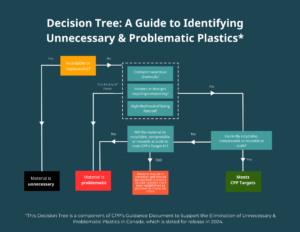
The flexibles dilemma: Navigating challenges and forging solutions for flexible plastic packaging in Canada
By Cher Mereweather, Managing Director, Canada Plastics Pact
Canadian Plastics Packaging Recycling SustainabilityFlexible packaging is often the best option, but it will likely remain a recycling problem for a few years to come.

Photo Credit: Adobe Stock/mykolastock
Once upon a time there was a plastic bag and a cardboard box. And every day they would take the Product of Goodness from one part of the kingdom to another, safely and joyfully. Together the bag and the box brought great joy to people across the kingdom. But one day the Great Brand Owner in the Sky appeared and told the bag and the box that together they were now too heavy. The bag and the box were sad, for they made a great team, and they made many people happy every day. But they knew that one of them would have to leave. The box even tried dieting, desperate to lose weight and stay with his friend the bag. But it was to no avail. And one day the bag found itself all alone. But this made the Almighty Merv very unhappy. For the bag, it complained, couldn’t be recycled. And so, it sent the bag to the Big Hole in the Ground where it stayed for the rest of its days. Now that troubled the Great Brand Owner in the Sky deeply. She didn’t want the bag to go to the Big Hole in the Ground, but the box on its own wasn’t strong enough to carry the Product of Goodness from one part of the kingdom to another. And together the box and the bag were just too heavy. She simply didn’t know what to do. So, the Great Brand Owner in the Sky went to the Almighty Merv and explained how troubled she was. And together they agreed to gather all their friends from across the kingdom and work hard to find a way to keep the bag from going to the Big Hole in the Ground. And a CPP Working Group was born…
I’ve had the immense privilege of leading the Canada Plastics Pact (CPP) for several months now. One of the things that I’ve learnt in my previous experiences leading source reduction and sustainability efforts in the food industry is the power of simplicity, in both strategy and communication. And so, I wanted to start this article with a parable – childlike in its simplicity – to illustrate what I believe is the crux of the issue we are facing around the use of flexible plastic packaging[1] in this country.
Many of the companies I have spoken to since arriving in this role have spoken to me with great passion about their work, done often over many years, to identify opportunities to reduce and eliminate their packaging. Not all, by any means, but a significant number. And they have shared how this work often inevitably pushed them towards flexible solutions. And how this has now put them between a rock and hard place. Reduce GHGs and packaging footprint by increasing reliance on flexibles, but in turn accept that more of their packaging goes to landfill. It’s what I’ve ended up calling the Flexibles Dilemma. And it’s not going to be resolved anytime soon.
At CPP, we recognize that plastic reduction is fraught with uncomfortable compromises and imperfect solutions. There is no magic wand or silver bullet and each area of the matrix of companies, sectors, interests, and stakeholders that make up the plastic supply chain moves at a different speed and for different reasons.
Out of this complexity come dilemmas. And under those circumstances, one size most definitely does not fit all.
As such, what matters here is not the decisions themselves: one company is going to choose flexibles while another is not, but the ‘Decision Tree,’ or how we make those decisions in an imperfect world.

Image Credit: Canada Plastics Pact
At CPP we will be doubling our efforts to accelerate the infrastructure solutions we need so that no more bags end up going to the Big Hole in the Ground. But until then, Brand Owners need to be supported in figuring out how to make the best decisions for themselves.
And that is why CPP has just published a Five-Year Roadmap (2023-2027) for Advancing Flexible Plastic Packaging in Canada. It’s designed for stakeholders across Canada. including manufacturers, producers and brown owners, retailers, stewardship agencies, recyclers, and governments, to work together on clear and practical objectives.
The Flexible Plastics Roadmap acknowledges the fact that in 2023, flexibles are a problem and are likely to remain so for a few years still to come. Even though flexible packaging and films represent 47% of the plastic packaging placed into the Canadian market (equal to 1.89 million tonnes in 2019), less than 2% is being effectively recycled. Average collection rates are only 15% for households and 6% for IC&I[2].
It also acknowledges the fact that, in many cases, flexible packaging is the best option. It is lightweight, adaptable, less costly, and reduces greenhouse gas emissions.
The Roadmap identifies three areas where we think we can collectively make progress.
The first is about mindset and how we think about packaging and the need for it. Entitled Upstream Innovation and Design for Circularity, the core principle here is that we must begin any work around flexibles by looking for opportunities to eliminate the plastics we don’t need, to move to other types of packaging or to replace packaging altogether where it makes sense.
Our mindset in this country is still primarily one of recycling rather than reduction, and this needs to change.
I was one of the pioneers of the food waste movement in Canada and have seen how the entire food industry was able to shift its thinking from how to deal with waste to how to prevent it in the first place. Similar coalitions to CPP worked over decades to drive the message to business leaders across the industry that they shouldn’t just be looking at the cost to dispose of food waste, but of all the embedded costs (raw material, labour, energy, opportunity cost of unsold products) of that waste. To a large extent it worked.
The extremely low cost of virgin plastics and the absence of similarly meaningful data on the embedded costs of plastics today mean that business leaders have a harder time with that narrative. While no-one wants a straw in a turtle’s nose, if a CFO must choose between virgin plastic or post consumer recycled (PCR) with the latter being more expensive, it’s a quick decision, turtle or no turtle.
I am committed to demonstrating to our industry that the same principles apply with plastics as they do with food waste, and we will be commissioning research to that end next year. We will also be unveiling the first of our new Accelerator Pods later this year focused on scaling re-use models across the country.
While reduction or re-use needs to be the priority, if you move through the Decision Tree and recognize that flexibles remain the best option for your company then the focus shifts to making good design decisions. And this is really about using packaging that creates the fewest barriers to recycling. To support these efforts, CPP has developed a Canadian version of the Golden Design Rules for Plastics Packaging.
Further, we are recommending that all CPP Signatories review their flexible plastic packaging portfolios by the end of 2024 to ensure packaging is easily identifiable and to explore and identify opportunities to switch to mono-polyethylene (PE) and mono-polypropylene (PP).mono-polypropylene (PP)[3].
If this is the stage you find yourself at in the Decision Tree, CPP recently published its Pathways to Mono-material Flexible Plastic Packaging Guide, as a supplement to the Flexibles Roadmap. This guide offers a host of practical information and guidance on how to move from multi-material flexible packaging to mono-PE or PP and was developed in line with the Golden Design Rules.
The final area of focus in the Flexible Plastics Roadmap is about sorting, recycling and end market development. The goal here is clear: a significant increase in flexible packaging sorting and recycling capacity enabling over 30% of household flexibles to be effectively recycled by the end of 2027, while at the same time supporting the creation of stable end markets for PCR content.
While, if you are a brand owner, these targets may feel a long way off, they matter. The plastics problem will only be solved by the whole supply chain working together. And that can only happen when there is clarity and understanding about the needs, motivations and drivers of each part of the chain.
At its heart, that is what CPP seeks to do.
In the meantime, we will continue to support those who are having to make imperfect choices while pushing for a world without plastic waste or pollution. A world with no more bags going into the Big Hole in the Ground.
Cher Mereweather is the Managing Director of the Canada Plastics Pact.
_______________________________________________________________________
[1] Flexible plastic packaging is a package or container made of flexible or easily yielding materials that, when filled or closed, can be readily changed in shape. There are two types of flexible plastic packaging: multi-material structures and mono-material structures.
[2] Canada Plastics Pact. (2021, May). Foundational Research & Study: Canadian Plastic Packaging Flows
[3] Mono-PE is a flexible packaging material composed of a single layer of polyethylene and Mono-PP is a type of flexible packaging material made from a single layer of polypropylene.
